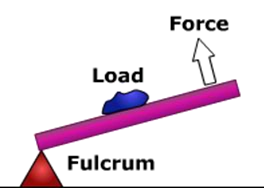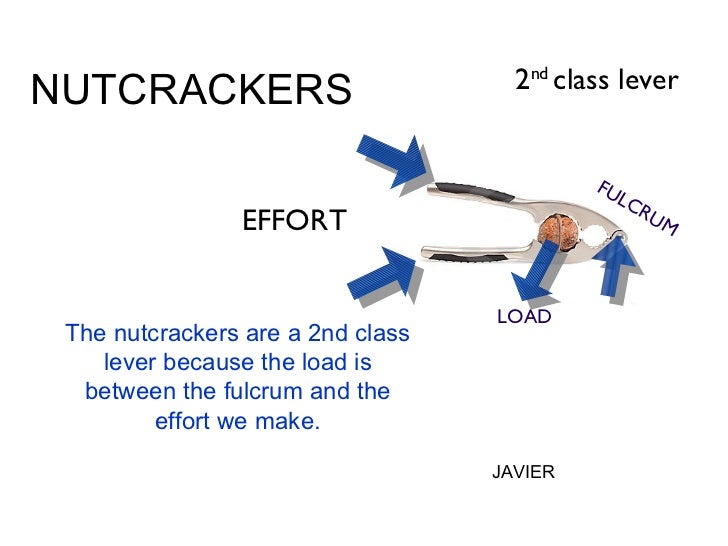Second Class Lever Nutcracker Keywords: second life, secondpc, secondary school, secondary, second extinction, second amendment, secondary logon, secondary index. The Class of Lever is determined by the location of the load, fulcrum, and force. In a Class Two Lever, the Load is between the Force and the Fulcrum. The closer the Load is to the Fulcrum, the easier the load is to lift. Examples include wheelbarrows, staplers, bottle openers, nut cracker, and nail clippers.
- Why Is A Nutcracker Second Class Lever Mechanical Advantage
- Why Is A Nutcracker Second Class Lever A Fulcrum Is Where
- Why Is A Nutcracker Second Class Lever In The Body
A lever is a rigid object that is used with an axis to either multiply the mechanical force (effort) or resistance force (load) applied to it. The efficiency of the lever is called mechanical advantage (MA). The greater the mechanical advantage, the less effort required. Mechanical advantage can be calculated by dividing the effort arm by the resistance arm (MA = EA/RA).
In assessing the efficiency of the lever (mechanical advantage), it is important to identify and quantify the components included in the system. This can be achieved by calculating the distance between the axis and the where the force acts.
Why Is A Nutcracker Second Class Lever Mechanical Advantage

3 Components to a Lever
- Axis (pivot or fulcrum)
- Resistive Load (weight)
- Force (effort)
The location of these 3 components determines the mechanical advantage and the lever class. It’s important not to confuse this with moment and torque, which will be discussed in the next post.
The fulcrum is located between the applied force and the load. Classic examples are a seesaw or crowbar.
Mechanical Advantage = 1
1st Class Levers in the Human Body

There are very few in the human body.
A rare example is the force of the triceps at the olecranon.
The load is situated between the fulcrum and the force. Therefore the force lever arm would always be greater than the load lever arm. Classic examples are a wheelbarrow, push-up exercise, or nutcracker.
Mechanical Advantage = Greater than 1
2nd Class Lever
2nd Class Levers in the Human Body
This class commonly occurs in the body when gravity, an external force, and or inertia is the effort force and muscles are the resistance (load). In this situation the muscle is contracting eccentrically against the force. Think of an eccentric biceps curl.
Another circumstance where this class occurs is when the muscle is acting on its proximal segment while the distal segment is fixed (weight bearing). The result is movement of the proximal lever. An example of this type of 2nd class lever is triceps surae lifting the body around the axis of the toes.
The force is applied between the fulcrum and the load. Therefore the load lever arm is always greater than the force lever arm. A classic example is a pair of tweezers or a diving board.
Mechanical Advantage = Less than 1
3rd Class Levers in the Human Body
Most muscles in the human body are 3rd class levers and create rotation of the distal segment. With this type of leverage the muscles would be acting concentrically, as long as the distal lever is free.
Why Is A Nutcracker Second Class Lever A Fulcrum Is Where
An example of this type of lever system is the biceps brachii acting concentrically on the forearm.
It may seem confusing that most of the muscles in the human body are 3rd class levers, since these levers are at a mechanical disadvantage in terms of effort versus load. However, this only holds true in terms of resistance. The opposite is true when you consider the distal lever displacement. A small arc of motion proximally at the muscle insertion will create large angular displacement and velocity distally. Since most human movement is aimed at maximizing angular displacement of a distal segment through space, the use of 3rd class levers for is very efficient.

Why Is A Nutcracker Second Class Lever In The Body
This creates a relationship between the lever arm distance, distal angular displacement/velocity, and torque production. The shorter the lever arm of the effort force (decreased mechanical advantage), the greater angular displacement and angular velocity of the distal end of the lever for a given arc of displacement of the effort force. The larger the lever arm of the effort force (increased mechanical advantage), the increased torque production.
This lever arm and force/torque production relationship needs to be taken into consideration when assessing movement and prescribing interventions. For example, applying a 5 pound weight at the distal end of a lever during a scaption/SLR exercise creates a mechanical disadvantage for the supraspinatus/illiopsoas. This results in the muscle being overloaded in attempt to create the amount of torque necessary for the distal angular displacement.
Understanding lever systems are a very important part of biomechanics. It helps to conceptualize the amount of effort force required for movement and also can determine the efficiency of static and dynamic positions. Once you determine the lever arm system, you can then begin to quantify moment and torque.
- A lever is an object that can multiply mechanical force (effort) or resistance force (load)
- Lever arm is the distance from the axis of rotation to the line of action of the force
- Mechanical Advantage is the efficiency of the lever system (MA=EA/RA)
- 1st Class Lever = fulcrum is located between the applied force and the load
- 2nd Class Lever = load is situated between the fulcrum and the force
- 3rd Class Lever = force is applied between the fulcrum and the load
- Lever System Assessment – Define lever system, identify lever arms (effort & load), determine lever class, calculate mechanical advantage
- Biomechanical Application – manipulate the lever arms to either increase or decrease mechanical advantage, depending on the therapeutic intention
Topics
Biomechanic Relationships
—
The main reason I do this blog is to share knowledge and to help people become better clinicians/coaches. I want our profession to grow and for our patients to have better outcomes. Regardless of your specific title (PT, Chiro, Trainer, Coach, etc.), we all have the same goal of trying to empower people to fix their problems through movement. I hope the content of this website helps you in doing so.
If you enjoyed it and found it helpful, please share it with your peers. And if you are feeling generous, please make a donation to help me run this website. Any amount you can afford is greatly appreciated.